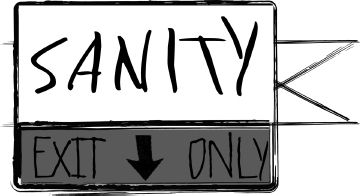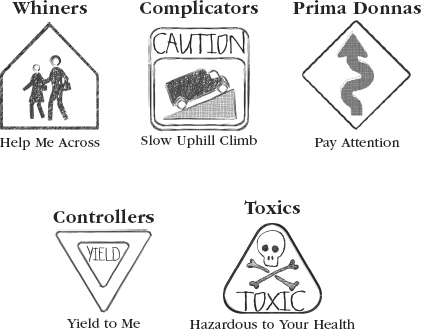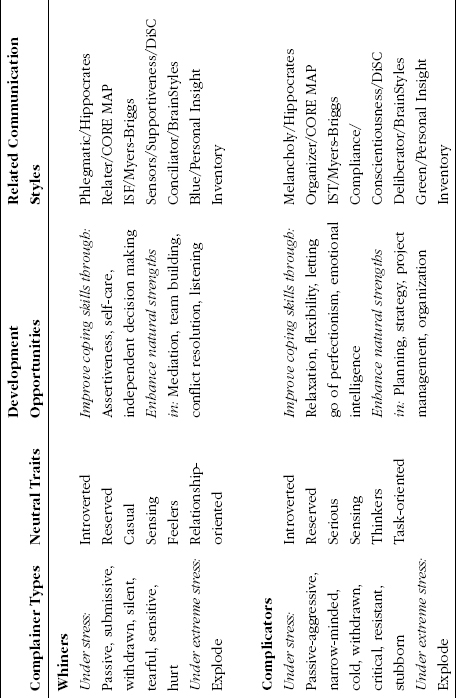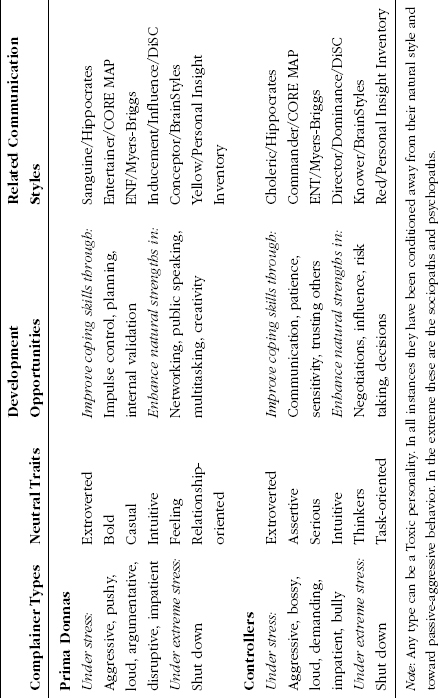Resources
Help Ahead

Complain-a-Grams to Complainer or Company Leader
If you want an anonymous way to notify someone that he or she is a Complainer or notify someone in leadership that there are Complainers or Energy Drains, you can copy these letters or download Complain-a-Grams from www.StopComplainers.com. Simply place a Complain-a-Gram with a copy of this book on the Complainer’s or leader’s desk when no one is around, or mail the note and book in an envelope addressed to him or her . . . without a return address of course!
Complainer Type Road Signs and Slogans
In the Complain-a-Grams, recipients are asked to go to www.StopComplainers.com and take the “Spot Your Complainer’s Type” or “Am I Seen as a Complainer?” The results of the assessments identify the type of Complainer, the frequency of complaining, a comparison to others’ results, and strategies to stop the behavior you spot.
Each Complainer type has its own road sign and slogan. These help you remember the wants of the Complainer and which strategies work when negotiating with your particular Complainer type.

Conversation Strategies per Complainer Type
It came as a surprise when the survey results revealed five different types of Complainers. Each of the five types has a specific way of complaining, including tone, conversation style, words, and behavior. The five types of Complainers also want different outcomes: empathy, stability, attention, results, and control. Here are strategies to turn Complainers to contributors.
- Whiners want empathy and connection. They complain by showing disapproval, venting, or withdrawing.
- Complicators want calm and stability. They complain by blocking, complicating, and creating confusion.
- Prima Donnas want recognition. They complain by seeking attention, gossiping, interrupting, and interfering.
- Controllers want action and to accomplish goals. They complain aggressively to control or reach an outcome.
- Toxics want to further a self-absorbed agenda. They complain to manipulate and poison the environment.
Related Communication Styles
In general, Complainer types correlate with commonly recognized styles of communication. The Complainers represent the dark side or negative behaviors that appear when people are placed under stress. Please see the following table for general descriptions identifying each type of Complainer and behaviors under stress as well as areas for improvement and development. Also listed are popular profiles and assessments that identify communication styles. Although these profiles don’t map precisely to each Complainer type, they each offer extensive coaching and training tools to help you and your Complainer identify strengths and communication strategies.


Negotiating Work Drama Checklists
Determine Direction to Take
| Questions and Decisions | Strategy |
| Work Drama Description | |
| Complainer Type? Traits to Consider? | |
|
|
|
| Determine types at www.StopComplainers.com | |
| Who? (Name, role, history, status) | |
| How is he or she perceived by others? | |
| Or | |
| Energy Drain Type? Items to Consider?
|
|
| Who is affected? How? Frequency? | |
| Impact | |
| How does behavior or situation negatively impact business or others? | |
| Best Direction to Take | |
| At this time, I’m choosing to:
|
Prepare to Negotiate Work Drama
| Questions and Decisions | Strategy |
| Decide to Negotiate | |
| What do I want? | |
| What are my personal reasons? | |
| How will the environment be better? | |
| Is it worth investing my time and effort? | |
| Does a potential reward outweigh my risk? | |
| Find the Right Supporters | |
| Who are the other stakeholders? | |
| How do others perceive my Complainer? | |
| Why is a change in their best interests? | |
| What do I want our leaders to do? | |
| What supporting documentation exists? | |
| What is realistic to expect from our organization? | |
| Detours and Roadblocks | |
| What could go wrong? | |
| What is my worst-case scenario? | |
| Can I live with it? | |
| What is my alternative or plan B? | |
| Have I left myself an out? | |
| Should I adjust course or proceed as planned? |
Remember, you are in the driver’s seat of your life and your career. Whether you decide to negotiate or not is your decision! Even if you determine to pursue another direction, the exercise of preparing a plan of action allows you to: think logically about work drama; create a roadmap if you later decide to turn things around; and attempt portions of negotiating now.
Negotiate Your Work Drama
| Questions and Decisions | Strategy |
| Set the Scene | |
| Where will I have this conversation? | |
| (ex. A private place without distraction.) | |
| How will I start the conversation? | |
| (ex. “I’m afraid I have difficult news.” Or “I’ve observed a serious issue.”) | |
| Negotiate with a Complainer | |
| Will a leader representative be present? | |
| If so, what is our plan and what role does he or she play? | |
| If not, have I warned leadership about possible reaction? | |
| What Complainer type do I have and what traits do I need to keep in mind? | |
| What will I say if my Complainer vents or becomes emotional? | |
| Negotiate to Stop Energy Drain | |
| What Energy Drain type do I have? | |
| How is investing expense and effort to correct drama a good business decision? | |
| Conversation | |
| What objections do I anticipate and how will I respond? | |
| What is my “out” or escape if needed? | |
| (ex. “I need to take a break.”) | |
| Wrap Up | |
| What is our agreement or next step? | |
| How will I document? |
Additional questions for determining your strategy in negotiating work drama are available at www.StopComplainers.com under Tools and Resources.
